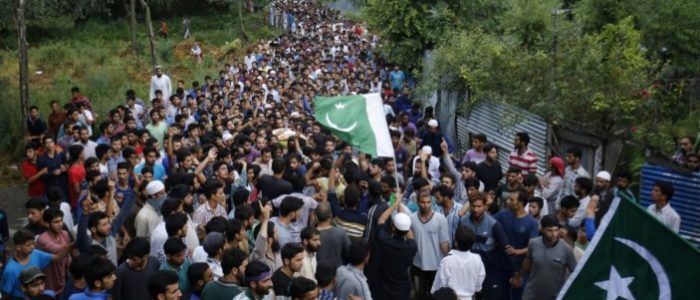Following the martyrdom of the Hizbul Mujahideen commander Burhan Wani on July 8, protests erupted in the Kashmir valley. Thousands of people defied the curfew to lay their hero to rest. The Indian security forces opened fire on the protestors, killing more than 50 people and injuring more than 3000 since then.
Internet and mobile phone services were also blocked in the region to cause hindrance in mobilization and communication of the protestors.
The usage of non-lethal weapons such as the pellet gun by the Indian forces to control the crowd may not increase the death toll, but does inflict torture and even blindness. Reminiscent of the 2010 protests – when the pellet guns were first used – the cartridge of a pellet gun sprays a few hundred pellets resembling ball bearings, piercing the human body. These non-lethal weapons have caused more than 3700 pellet injuries in Kashmir during the ongoing struggle, among which half of them are serious eye injuries. Doctors have been unable to restore the full vision of those affected. Amnesty International India, along with other human rights organizations, has called for stopping the use of excessive force. “Pellet-firing shotguns fire a large number of small pellets spreading over a wide range. Their use is not in line with international standards on the use of force, as they cannot ensure well-targeted shots and risk causing serious injury, including bystanders or other protesters not engaging in violence,” said Amnesty International.
The current cycle of violence is proving to be the deadliest since the 2010 protests in Kashmir, in which 120 civilians were killed by the Indian troops. The right to protest, the right to freedom of expression and the right of self determination are not just denied to the Kashmiris, but demanding for these rights may even take away the right to life from them.
The slain commander, Burhan Wani was the symbol of the Kashmiri freedom movement. Young, enthusiastic and fearless, Wani reignited the flame of Aazadi among the Kashmiri youth. Wani was only 15 when he joined the armed struggle, when he and his brother were beaten by the Indian forces in 2010. He led a group of young, educated and social-media savvy freedom fighters, who were not afraid to flaunt their rebel identity online. Wani was an inspiration for the Kashmiris; he was one of their own. The presence of over 200,000 people despite the curfew in Wani’s funeral is testament of the love they had for him.
Burhan Wani’s martyrdom has immortalized him. The legacy he left behind for the youth of Kashmir is that of unwavering courage and determination. It was Wani who inspired the youth which grew up under fear and oppression, which faced torture, persecution and humiliation at the hands of Indian security forces, a youth whose screams were muffled by ‘the largest democracy in the world’, before they could reach others.
After being suppressed through ‘lawless laws’ such as the Public Safety Act – under which anyone can be detained for two years in jail without a trial- the new generation of Kashmiris has resorted to the social media to make their voices heard. According to a police report, ‘the accessibility to social media (in the Kashmir Valley) was 25 per cent in 2010, which rose to 30 per cent in 2014 and sharply escalated to 70 per cent in 2015’. Through beating indigenous reporters, banning stories and seizing copies of local newspaper, the Indian state has clamped down on local voices from reaching the international community, presenting their version of the Kashmir unrest on the national media. In times of deep crisis, Internet, particularly social media, provided the freedom fighters’ with a forum.
But freedom of expression remains restricted. Through blocking Internet access and cellular networks in the valley, communication and mobilization is hindered. Facebook also works in tandem to silence dissent, answering to ‘complaints’ by suspending controversial posts on Kashmir. New media are also being used as apparatus of state surveillance to keep an eye on prospective rebels.
Despite the attempts of shutting down dissent in Kashmir, the death of Wani is proving to be no ‘victory for the Indian state’. The conviction of Kashmiris observed during the past few days, in spite of the inhumane treatment by state force, speaks volumes about their thirst for freedom. Their hero may have slept, but the youth of Kashmir has risen.
